Prime
MTN clients borrowed Shs435b in mobile money loans in 2020

The appetite for mobile money micro credit has been growing since it was established in 2016. PHOTO | FILE
MTN subscribers borrowed about Shs435b in mobile money loans during the period ended 2020, pointing to the increased appetite for short term credit.
In 2016, MTN launched Mokash, a micro lending platform, in which it operates in partnership with Commercial Bank of Africa (CBA) as the lead financier to extend credit to customers through mobile money.
The bank, which has since changed to NCBA, according to MTN, disbursed 4.7 million mobile loans in 2020, with each attracting a 9 per cent interest.
“NCBA Bank in partnership with MTN issued over 4.7 million loans worth Shs435b in 2020 alone,” Mr Stephen Mutana, the MTN general manager for mobile financial services, said, noting that since inception, NCBA has lent out more than Shs950b, which signals the increased need for instant credit.
In 2018, Ms Elsa Muzzolini, the then MTN head of mobile money division, said the company had given out in the excess of Shs100b in only three years through Mokash and had about 3.5 million enrolled subscribers.
The partnership allowed NCBA to tap into MTN’s large mobile money customer base, which currently sits at above 13 million subscribers.
Mokash, which provides credit for a period of 30 days at 9 per cent, also encourages customers to save through the platform from which they equally earn 9 per cent interest per annum on the savings.
Mr Mutana said more than 2.5 million customers have saved nearly Shs16b through the platform, which creates an alternative to the already existing platforms.
Mobile money has been critical in the drive towards financial inclusion through extending savings, person to person transactions, insurance, digital payment and several other digital services to Ugandans.
A Finscope survey released in 2018 revealed that mobile money was the major driver of financial inclusion, which currently stands at 78 per cent with 23 per cent of adults saving money through mobile services, compared to 11 per cent in commercial banks and related financial institutions.
Uganda still has a low bank penetration rate because the number of people with bank accounts is still low compared to those with mobile phones and mobile money.
According to Mr Wilbrod Owor, the Uganda Bankers’ Association executive director, there are currently 17.5 million accounts in the country compared to about 25.9 million mobile money subscribers, according to data from Uganda Communications Commission.
High interest rates
Commercial banks have been blamed for frustrating efforts by Ugandans to join the banking industry by charging high interest rates and strenuous prerequisites to access credit.
Recently, the Central Bank warned commercial banks after they had failed to respond reasonably to Bank of Uganda’s bid to bring down interest rates.
Bank of Uganda, which had maintained the Central Bank Rate, a key determinant of commercial bank interest rates, at 7 per cent, said it was unfair to keep interest rates high in disregard of the Central Bank’s actions.
Most banks in Uganda lend to customers at an interest rate of above 20 per cent.
Stanbic Bank, however, recently announced that it would be reducing its prime lending rate to 16 per cent as an incentive to the public having gone through the economic paralysis under lockdown.




